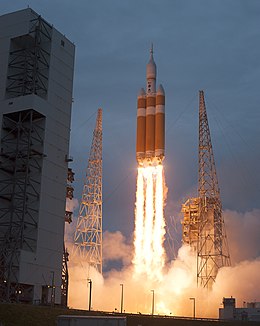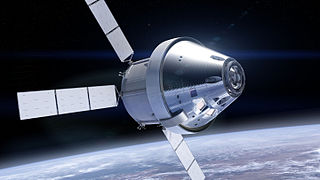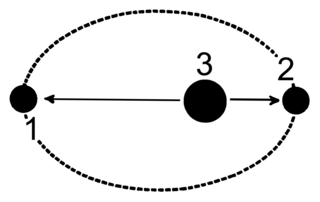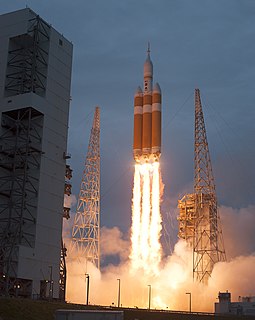 Launch of EFT-1 on December 5, 2014 | |
| Mission type | Uncrewed test flight |
|---|---|
| Operator | NASA |
| COSPAR ID | 2014-077A |
| SATCAT no. | 40329 |
| Mission duration | 4 hours, 24 minutes |
| Orbits completed | 2 |
| Spacecraft properties | |
| Spacecraft type | Orion MPCV |
| Manufacturer | Lockheed Martin |
| Start of mission | |
| Launch date | December 5, 2014, 12:05 UTC (07:05 EST) [1] [2] |
| Rocket | Delta IV Heavy |
| Launch site | Cape Canaveral SLC-37B |
| Contractor | United Launch Alliance |
| End of mission | |
| Recovered by | USS Anchorage |
| Landing date | December 5, 2014, 16:29 UTC |
| Landing site | Pacific Ocean, 640 miles (1,030 km) SSE of San Diego 23°37′N114°28′W / 23.61°N 114.46°W |
| Orbital parameters | |
| Reference system | Geocentric |
| Apogee | 5,800 kilometres (3,604 mi) |
Orion Program | |
Exploration Flight Test 1 or EFT-1 (previously known as Orion Flight Test 1 or OFT-1) was the first test flight of the Orion Multi-Purpose Crew Vehicle. Without a crew, it was launched on December 5, 2014, at 12:05 UTC (7:05 am EST), by a Delta IV Heavy rocket from Space Launch Complex 37B at Cape Canaveral Air Force Station.

The Orion Multi-Purpose Crew Vehicle is an American-European interplanetary spacecraft intended to carry a crew of four astronauts to destinations at or beyond low Earth orbit (LEO). Currently under development by the National Aeronautics and Space Administration (NASA) and the European Space Agency (ESA) for launch on the Space Launch System, Orion is intended to facilitate human exploration of the Moon, asteroids and of Mars and to retrieve crew or supplies from the International Space Station if needed.

The Eastern Time Zone (ET) is a time zone encompassing part or all of 22 states in the eastern part of the contiguous United States, parts of eastern Canada, the state of Quintana Roo in Mexico, Panama in Central America, and the Caribbean Islands.

The Delta IV Heavy is an expendable heavy-lift launch vehicle, the largest type of the Delta IV family and the world's second highest-capacity rocket in operation. It is manufactured by United Launch Alliance and was first launched in 2004.
Contents
The mission was a four-hour, two-orbit test of the Orion crew module featuring a high apogee on the second orbit and concluding with a high-energy reentry at around 20,000 miles per hour (32,000 km/h; 8,900 m/s). [3] This mission design corresponds to the Apollo 4 mission of 1967, which validated the Apollo flight control system and heat shield at re-entry conditions planned for the return from lunar missions.

The term apsis refers to an extreme point in the orbit of an object. It denotes either the points on the orbit, or the respective distance of the bodies. The word comes via Latin from Greek, there denoting a whole orbit, and is cognate with apse. Except for the theoretical possibility of one common circular orbit for two bodies of equal mass at diametral positions, there are two apsides for any elliptic orbit, named with the prefixes peri- and ap-/apo- added to a reference to the body being orbited. All periodic orbits are, according to Newton's Laws of motion, ellipses: either the two individual ellipses of both bodies, with the center of mass of this two-body system at the one common focus of the ellipses, or the orbital ellipses, with one body taken as fixed at one focus, and the other body orbiting this focus. All these ellipses share a straight line, the line of apsides, that contains their major axes, the foci, and the vertices, and thus also the periapsis and the apoapsis. The major axis of the orbital ellipse is the distance of the apsides, when taken as points on the orbit, or their sum, when taken as distances.

Atmospheric entry is the movement of an object from outer space into and through the gases of an atmosphere of a planet, dwarf planet, or natural satellite. There are two main types of atmospheric entry: uncontrolled entry, such as the entry of astronomical objects, space debris, or bolides; and controlled entry of a spacecraft capable of being navigated or following a predetermined course. Technologies and procedures allowing the controlled atmospheric entry, descent, and landing of spacecraft are collectively termed as EDL.

Apollo 4,, was the first unmanned test flight of the Saturn V launch vehicle, which was used by the U.S. Apollo program to send the first astronauts to the Moon. The space vehicle was assembled in the Vertical Assembly Building, and was the first to be launched from Launch Complex 39 at the John F. Kennedy Space Center on Merritt Island, Florida, facilities built specially for the Saturn V.
NASA heavily promoted the mission, collaborating with Sesame Street and its characters to educate children about the flight test and the Orion spacecraft. [4]

The National Aeronautics and Space Administration is an independent agency of the United States Federal Government responsible for the civilian space program, as well as aeronautics and aerospace research.

Sesame Street is an American educational children's television series that combines live action, sketch comedy, animation and puppetry. It is produced by Sesame Workshop and was created by Joan Ganz Cooney and Lloyd Morrisett. The program is known for its images communicated through the use of Jim Henson's Muppets, and includes short films, with humor and cultural references. The series premiered on November 10, 1969, to positive reviews, some controversy, and high viewership; it has aired on the U.S.'s national public television provider PBS since its debut, with its first run moving to premium channel HBO on January 16, 2016.


































